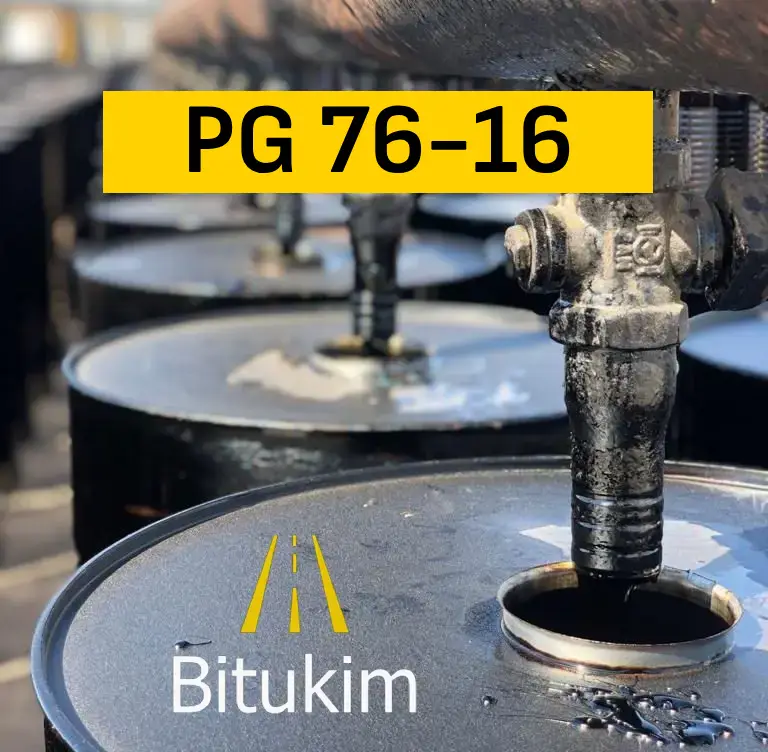What is PG 76-16 Bitumen?
PG 76-16 is a high-performance, polymer-modified bitumen (PMB) designed for hot climates and heavy traffic. The “76-16” indicates its performance at high pavement temperatures (76°C) and moderate cold (-16°C), ensuring durability without losing flexibility. Developed according to Superpave specifications, PG 76-16 is ideal for modern pavements. As a leading supplier of Bitumen PG 76-16, Bitukim provides premium-quality bitumen for sustainable infrastructure projects. (Contact Us)
Why Choose PG 76-16 from a Reliable Supplier?
Polymer-modified PG 76-16, enhanced with materials like Styrene-Butadiene-Styrene (SBS), offers superior elasticity and strength. These polymers improve resistance to rutting, cracking, and water damage, making them well-suited for high-stress conditions. A trusted supplier like Bitukim ensures consistent quality, meeting industry standards such as ASTM D6373 for performance grading.
Key Benefits of PG 76-16
-
Rutting Resistance: Withstands deformation in hot climates and high-traffic areas.
-
Crack Prevention: Maintains flexibility in moderate cold, reducing cracking.
-
Aging Resistance: Resists oxidation, prolonging pavement life.
-
Elastic Recovery: Absorbs stress from heavy loads for lasting performance.
-
Strong Adhesion: Bonds well with aggregates, minimizing moisture damage.
-
Cost Efficiency: Reduces maintenance costs through longer-lasting pavements.
Applications of PG 76-16
PG 76-16 is used in high-stress infrastructure projects, including:
-
Highways and Expressways: Handles heavy traffic and extreme weather.
-
Urban Roads: Ideal for stop-and-go traffic at intersections.
-
Airports: Supports runways, taxiways, and aprons under heavy loads.
-
Ports and Industrial Yards: Durable for container terminals and port roads.
-
Maintenance Overlays: Enhance existing pavements with stress-absorbing layers.
Choosing a Bitumen PG 76-16 Supplier
Selecting a reliable supplier is crucial for project success. Look for:
-
Quality Certifications: Ensure compliance with ISO standards and Superpave specifications.
-
Reliable Delivery: Timely supply to keep projects on schedule.
-
Technical Support: Expert guidance on handling and applications.
-
Global Reach: Suppliers like Bitukim serve regions like the Middle East, ensuring accessibility.
Bitukim, a premier Bitumen PG 76-16 supplier, offers certified products, prompt delivery, and expert support for your paving needs.
Handling and Storage Best Practices
To maintain PG 76-16 quality:
-
Storage Temperature: Keep between 160°C and 175°C.
-
Mixing Temperature: Apply at 155°C–170°C.
-
Avoid Overheating: Stay below 180°C to prevent polymer breakdown.
-
Use Insulated Tanks: Minimize heat loss during storage.
-
Gentle Stirring: Ensure even polymer distribution.
These practices prevent premature aging and ensure optimal performance.
Sustainability and Economic Benefits
PG 76-16 supports eco-friendly projects by extending pavement life, reducing repairs, and lowering resource use. It’s compatible with Reclaimed Asphalt Pavement (RAP) and can contribute to LEED certification. Choosing a Bitumen PG 76-16 Supplier like Bitukim ensures sustainable, cost-effective solutions.
Contact Bitukim for Your PG 76-16 Needs
For durable, high-performance bitumen, partner with Bitukim, your trusted Bitumen PG 76-16 supplier. Contact us today:
-
Address: No. 2305, Burlington Tower, Business Bay, Dubai, UAE
-
Phone: +(971) 4 566 4998
-
Mobile: +971 (50) 940 9246
-
Email: info@bitukim.com
Visit our product page or learn more about Superpave standards to ensure you select the best bitumen for your project. Your project. (Contact Us)
Specification of PG 76-16
| Specification | Unit | Value | Method |
|---|---|---|---|
| Average 7-Day Maximum Pavement Design Temperature | °C | <76 | – |
| Minimum Pavement Design Temperature | °C | > -16 | – |
| Flash Point Temperature | °C | Min230 | AASHTO T48 |
| Viscosity, T 316, Maximum 3 Pas, Test Temp, °C | °C | 135 | AASHTO T316 |
| Dynamic Shear, T 315, G*/sin Minimum 1.00 KPa Test Temperature, @10 rad/s,°C | °C | 76 | AASHTO T315 |
| Rolling Thin Film Oven Test (T 240) | |||
| Mass Change, Maximum, Percent | % | 1.00 | AASHTO T240 |
| Dynamic Shear G*/sin Minimum 2.2 KPa Test Temperature, @10 rad/s | °C | 76 | AASHTO T315 |
| Pressure Aging Vessel (PAV) Test (AASHTO R28) | |||
| PAV Aging Temperature | °C | 100 | AASHTO R28 |
| Dynamic Shear G*/sin Maximum 5000 KPa Test Temperature, @10 rad/s | °C | 34 | AASHTO T315 |
| Creep Stuffiness S Maximum 300 Mpa M-Value Minimum 0.300 Test Temp,@60s | °C | -6 | AASHTO T313 |
| Direct Tension, T 314, Failure Strain, Minimum 0.300 Test Temperature, @60s, °C | °C | -6 | AASHTO T314 |
| Critical Low Cracking Temp, PP42, Critical Cracking Temp Determined by PP 42,Test Temp, °C | – | -6 | AASHTO PP42 |


